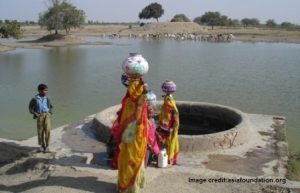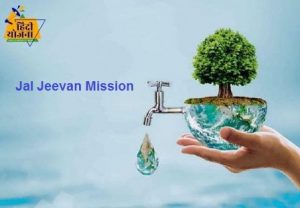A Year after Jal Shakti: A Paradigm Shift in Water Policy?
Over the next decade, it is extremely important to foster a social consciousness around the right to life of India’s water bodies beyond their utility for human sustenance.
India is one of the most water-stressed countries in the world with just 4 per cent of the world’s freshwater resources and 17 per cent of its population. Water supply is becoming  scarce due to reasons including, but not limited to, drastically falling water tables, contamination of surface and groundwater sources, the geographical distribution of water sources, and climate change. The Mihir Shah Committee Report on Water Reforms submitted in 2016 concluded that due to uneven distribution of water in the country, water scarcity has been aggravated further, and if it continues, about half of the demand for water will be unmet by 2030. Additionally, there is an expected gap of about 570 billion cubic meters (BCM) of water mainly in the agricultural sector by 2030, which could threaten India’s food security; to tackle the same, investments of INR 20,00,000 crore or more might be required.
scarce due to reasons including, but not limited to, drastically falling water tables, contamination of surface and groundwater sources, the geographical distribution of water sources, and climate change. The Mihir Shah Committee Report on Water Reforms submitted in 2016 concluded that due to uneven distribution of water in the country, water scarcity has been aggravated further, and if it continues, about half of the demand for water will be unmet by 2030. Additionally, there is an expected gap of about 570 billion cubic meters (BCM) of water mainly in the agricultural sector by 2030, which could threaten India’s food security; to tackle the same, investments of INR 20,00,000 crore or more might be required.
The scarcity and lack of equitable accessibility of water are two long-running problems in the country. As per NSSO’s 76th round survey conducted in 2018, a hand pump was the primary source of drinking water among rural households, while piped water was the main source among urban households. This shows a clear disparity between the rural and urban water supply systems, even as overall access to improved water sources has witnessed an increase from 68 per cent in 1992–93 to 89.9 per cent in 2015–16.The Composite Water Management Index 2019 also indicated a worrying trend in water management across states as 16 out of 27 states scored less than 50 per cent of the total achievable score. Notably, these states account for about 48 per cent of India’s population, 40 per cent of its agricultural output and 35 per cent of economic output.
The Modi government, as a policy response to this, renamed the Ministry of Water Resources to the Ministry of Jal Shakti in May 2019. The idea behind the move was to approach water management holistically, addressing the issues of demand and supply, access and quality by bringing all concerned departments under one single ministry.
Also Read : Delhi’s growing water crisis: ‘Day Zero’ is not far
Along with this, the government also launched two key missions oriented towards water conservation and improved accessibility.
The Jal Jeevan Mission (JJM) was launched on August 15, 2019 to provide affordable and regular drinking water supply in “adequate quantity of prescribed quality” to all rural households by 2024. The Jal Shakti Abhiyan (JSA) was a short-term mission-mode campaign implemented over two phases to promote water conservation and community resource management in the most water-stressed districts of India. The first phase ran between 1 July and 15 September 2019 in all states and UTs and the second ran from 1 October to 30 November 2019 in states receiving retreating monsoons like Andhra Pradesh and Tamil Nadu.
As noted earlier, the next decade is supposed to be a critical time for water policies in India. The JJM and the JSA being the flagship schemes indicating a renewed focus on water management and conservation, it is important to compare these two policies to previous policy frameworks.
Key Trends in India’s Water Policy
Water is a state subject under the 7th schedule of the Indian constitution, with states traditionally having the power to create laws on supply, irrigation, power, and storage related to all water resources falling within their respective state limits. Although the central government has come up with national frameworks on water management from time to time, its legislative powers are essentially concerned with issues like inland navigation and effective resolution of water disputes between states and with neighbouring countries.
Water management in the first few decades after India’s Independence was based around an extractive approach. More focus was placed on the construction of reservoirs, dams and canals for industrial and agricultural usage. In the 1980s, Integrated Water Resources Management (IRWM) became a part of water policies to address the three Es – economic efficiency, environmental sustainability and equity. IRWM was aimed at both water quality and quantity along with a tertiary focus on the physical environment and socio-economic aspects.
The first National Water Policy was introduced in 1987by the erstwhile Ministry of Water Resources. The policy came up in the context of increasing water demand for industrial, domestic, and agricultural use. One important aspect was the pollution of water resources and measures to improve their quality. Integrated and coordinated development of surface and groundwater was also envisaged. Water allocation priorities were listed out where drinking water was put first and industrial and other uses, last. The objective was to provide adequate drinking water to both rural and urban areas by 1991. The policy was later reviewed and updated in the face of new challenges in water management.
 In the 1990s, community management of water supply systems was encouraged with the involvement of organisations like the World Bank, more so for groundwater resources. This approach was solidified further as part of the National Water Policy 2002 which emphasised the involvement of users and local bodies in water management. The new policy acknowledged the uneven availability of water and proposed an integrated and multidisciplinary approach to planning and development of water projects. The policy retained water allocation priorities from its predecessor with drinking water being given the highest priority with a focus on minimising losses. The policy was aimed at economical, optimal and equitable use of water. Thereafter, under the framework of the National Water Policy 2012, the concept of community participation was taken further. Removal of disparity in water supply between rural and urban areas was one of the key goals of the new policy.
In the 1990s, community management of water supply systems was encouraged with the involvement of organisations like the World Bank, more so for groundwater resources. This approach was solidified further as part of the National Water Policy 2002 which emphasised the involvement of users and local bodies in water management. The new policy acknowledged the uneven availability of water and proposed an integrated and multidisciplinary approach to planning and development of water projects. The policy retained water allocation priorities from its predecessor with drinking water being given the highest priority with a focus on minimising losses. The policy was aimed at economical, optimal and equitable use of water. Thereafter, under the framework of the National Water Policy 2012, the concept of community participation was taken further. Removal of disparity in water supply between rural and urban areas was one of the key goals of the new policy.
Hitherto, India’s national water policies have placed primary importance on equitable distribution of drinking water. There has also been a secondary emphasis on water scarcity and pollution. However, given the current state of India’s water sector laid out in the previous section, these policies have failed to achieve their objectives with each subsequent policy listing lofty aims seemingly without taking into account implementational failures from the past.
The JJM and JSA: A Shift in Priorities?
The JJM and JSA, as briefly noted earlier, are aimed at improving water accessibility in rural areas as well as promoting water conservation in water-stressed regions.
As of March 2019, before the launch of JJM, 3.27 crore out of an identified total of 17.87 crore rural households (about 18.3 per cent) had piped water connections. States like Uttar Pradesh, Bihar, Jharkhand, Odisha, Chhattisgarh, West Bengal, Assam, etc. had less than 10 per cent of piped water coverage among rural households while Haryana, Gujarat, Maharashtra and Sikkim had the highest coverage. Comparatively, as on 4 October 2020, 5.5 crores out of an identified 18.9 crore rural households have functional household tap connections (FHTC) indicating a coverage of around 29.3 per cent households. The data also indicate that most states have improved their coverage with Haryana, Gujarat and Telangana reporting more than 75-98 per cent coverage. Among states with lowest coverage, Bihar has reported the highest improvement with 53 per cent coverage while Uttar Pradesh, Jharkhand, Assam and West Bengal still report under 10 per cent coverage.
The mission also includes intensive village-wise analysis, the formation of village action plans through water and sanitation committees under Gram Panchayats, and water quality surveillance through community participation.
Also Read : National Waterways: The Lifeline of India
However, there is no qualitative assessment yet available to gauge the functionality of water connections round the year, particularly in drought-prone areas. Data on water quality show that out of 1.5 crore sources, just over 1 crore have been tested out of which 22.9 lakh have chemical contaminants and 12.7 lakh have bacteriological contaminants present above permissible limit. Some water experts have, however, raised questions on the transparency and reliability of the data.
Under the JSA, interventions were made to encourage rainwater harvesting, renovation of traditional tanks and water bodies, reuse and recharge structures, watershed development, and intensive afforestation in 1592 water-stressed blocks across 256 districts. Thus, the construction and restoration of water conservation structures under JSA was considerably fast-paced given its two phases ran for roughly five months. However, a qualitative analysis of groundwater status in the post-intervention stage showed that 20 out of 26 states/UTs saw groundwater increase in less than 50 per cent districts. Notably, none of the districts in Andhra Pradesh, Assam, Bihar, Chhattisgarh, Haryana, Jharkhand, Odisha, Uttarakhand and West Bengal reported an increase in groundwater levels.
Thus, while there have been tangible improvements under both the schemes, the qualitative aspects have revealed clear challenges. The progress under JJM is monitored and updated in real-time, which is a significant improvement from previous interventions. Although one can’t notice a paradigm shift, the government is certainly trying to achieve a balance between equitable access and overall water availability. However, these are two seemingly incongruent objectives as increased accessibility under the JJM entails an increase in water usage. Improved accessibility without restrictions on usage could lead to over-exploitation, regardless of any parallel provisions for water conservation. In the long-run, this could worsen the water demand-supply gap, especially in the agriculture sector.
India’s water policies have conventionally favoured unproductive and inefficient use of water aided by weak government institutions and inefficient data collection. This seems to be changing with improvements in monitoring and increased convergence after the setting up of the Ministry of Jal Shakti. Increasingly, however, restrictive policy measures are required to disincentivise water wastage across sectors. Ramaswamy R Iyer, a veteran water policy expert who passed away in 2015, called for restrictions to be placed on the growing demand for water itself to move towards a low water economy which involves a significant decrease in our water footprint. Other experts like K J Joy have highlighted the need to set up participatory institutions at different levels and not just on the national level towards a collective ownership of water management. Over the next decade, it is extremely important to foster a social consciousness around the right to life of India’s water bodies beyond their utility for human sustenance.
(This article is part of content collaboration with the Social & Political Research Foundation, New Delhi)
